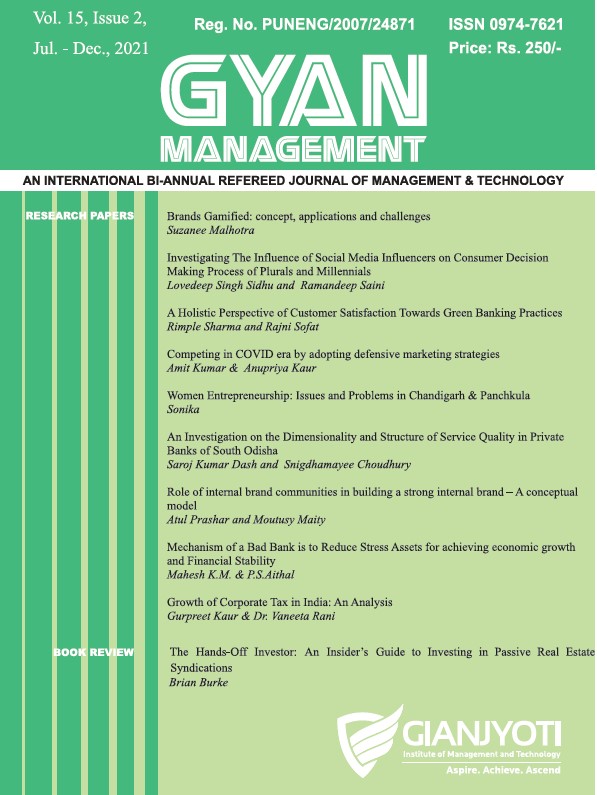Bibliometric Analysis of Global Research on Classroom Incivility
DOI:
https://doi.org/10.48165/gmj.2023.18.2.11Keywords:
Classroom Incivility, Uncivil Behaviour, Student Incivility, Bibliometric AnalysisAbstract
Purpose- The purpose of this study is bibliometric analysis of classroom incivility articles published in the journals indexed in Scopus database between 1996 to 25th May, 2023. Design/Methodology/Approach- In bibliometric analysis, a systematic review of classroom incivility using Scopus database has been done. Findings- The publishing trend indicated that the analysis in the field of classroom incivility is in nascent stage. Regarding journals, citation impact, co-authorship, institutions, and authors in this research topic, the United States placed first. Classroom incivility has mainly been associated with nursing field. The most influential journals are Journal of Nursing Education followed by Nurse Educator, Nurse Education Today, and Nursing Education Perspectives. And the most popular keywords are student incivility, social behaviour, incivility and classroom incivility on the basis of their occurrence.
Downloads
References
Alberts , H. C., Hazen , H. D., & Theobald, R. B. (2010). Classroom incivilities: The challenge of interactions between college students and instructors in the US.
Journal of Geography in Higher Education, 34(3), 439–462.
Altmiller, G. (2012). Student Perceptions of INCIVILITY in Nursing Education:Implications for Educators. Nursing Education Research, 33(1), 15-20.
Andersson, L. M., & Pearson, C. M. (1999). Tit for Tat? The Spiraling Effect of Incivility in the Workplace. Academy of Management, 24(3), 452-471.
Arbuckle , C., & Little, E. (2004). Teachers’ Perceptions and Management of Disruptive Classroom. Australian Journal of Educational & Developmental Psychology, 4(1), 59-70.
Berger, B. A. (2000). Incivility. American Journal of Pharmaceutical Education, 64(4), 445-450.
Bjork, S., Offer, A., & Soderberg, G. (2014). Time series citation data: the Nobel Prize in economics. Scientometrics, 98(1), 185–196.
Bjorklund, W. L., & Rehling, D. L. (2009). Student Perceptions of Classroom Incivility. 58(1), 15-18. Black , L. J., Wygonik, M. L., & Frey, B. A. (2011). Faculty Preferred Strategies to Promote a Positive Classroom Environment. Journal on Excellence in College Teaching, 22(2), 1-26.
Boice, B. (1996). Classroom Incivilities. Research in Higher Education, 37(4), 453-486.
Bornmann, L., & Mutz, R. (2015). Growth Rates of Modern Science: A Bibliometric Analysis Based on the Number of Publications and Cited References. Journal of the Association for Information Science and Technology, 66(11), 2215–2222.
Caza, B. B., & Cortina, L. M. (2007). From Insult to Injury: Explaining the Impact of Incivility. 29(4), 335-350. Caza, B. B., & Cortina, L. M. (2010). From Insult to Injury: Explaining the Impact of Incivility. Basic and Applied Social Psychology, 29(4), 335-350.
Clark, C. M. (2008). Faculty and Student Assessment of and Experience with Incivility in Nursing Education. 47(10), 458–465.
Clark, C. M., & Springer, P. J. (2007). Thoughts on incivility: student and faculty perceptions of uncivil behavior in nursing education. 28(2), 93-7.
Clark, C. M., Farnsworth, J., & Landrum, R. (2009). Development and description of the incivility in nursing education (INE) survey. Journal of Theory Construction & Testing, 13(1), 7-15.
Cortina, L., Lonsway, K. A., Magley, V., & Freeman, L. (2002). What’s Gender Got To Do with It? Incivility in the Federal Courts. 27(2), 235-270.
Donthu, N., Kumar, S., Mukherjee, D., Pandey, N., & Lim, W. M. (2021a). How to conduct a bibliometric analysis: An overview and guidelines. Journal of Business Research, 133(11), 285-296.
Donthu, N., Kumar, S., Pandey, N., & Lim, W. M. (2021b). Research Constituents, Intellectual Structure,and Collaboration Patterns in Journal of International Marketing: An Analytical Retrospective. Journal of International Marketing, 29(2), 1-25.
Fassinger, P. A. (1995). Professors’ and Students’ Perceptions of Why Students Participate in Class. Teaching Sociology, 24(1), 25-33.
Feldmann, L. J. (2001). Classroom Civility is Another of Our Instructor. College Teaching, 49(4), 137-140. Ferris, D. L., Chen, M., & Lim, S. (2017). Comparing and
Contrasting Workplace Ostracism and Incivility. Annual Review of Organizational Psychology and Organizational Behavior, 4(1), 315-338.
Harzing, A. W. (2007). https://harzing.com/resources/ publish-or-perish.
Kopp, J. P., & Finney , S. J. (2013). Linking academic entitlement and student incivility using latent means modeling. The Journal of Experimental Education, 81(3), 322-336.
Kuhlenschmidt, S. L., & Layne, L. E. (1999). Strategies for Dealing with Difficult. New directions for teaching and learning, 1(77), 45-58.
Lampman, C., Phelps, A., Bancroft, S., & Beneke, M. (2009). Contrapower Harassment in Academia: A Survey of Faculty Experience with Student Incivility, Bullying, and Sexual Attention. 60(1), 331–346.
Meyers , S. A., Bender, J., Hill, E. K., & Thomas, S. Y. (2006). How Do Faculty Experience and Respond to Classroom Conflict? International Journal of Teaching and Learning in Higher Education, 18(1), 180-187.
Moher, D., Liberati, A., Tetzlaff, J., & Altman, D. G. (2009). Preferred Reporting Items for Systematic Reviews and. PLoS Medicine, 6(7), 1-6.
Montgomery, K., Kane, K., & Vance, C. M. (2004). Accounting for Differences in Norms of Respect: A Study of Assessments of Incivility through the Lenses of Race and Gender. 29(2), 248-268.
Segrist, D., Bartels, L. K., & Nordstrom, C. R. (2018). “But Everyone Else is Doing It:” A Social Norms Perspective on Classroom Incivility. College Teaching, 66(4), 181-186.
Settles, I. H., & O’Connor, R. C. (2014). Incivility at academic conferences: Gender differences and the mediating role of climate. Sex Roles, 71(1), 71-82.
Singh, P., Karmakar, M., Leta, J., Mayr, P., & Singh, V. K. (2021). The journal coverage of Web of Science, Scopus. Scientometrics, 126(6), 5113-5142.
Sun, R. C., & Shek, D. T. (2012). Student Classroom Misbehavior: An Exploratory Study Based on. The Scientific World Journal, 2012(1), 1-8.
Van Eck, N. J., & Waltman, L. (2009). Software survey: VOSviewer, a computer program. Scientometrics, 84(1), 523–538.
Vowell, P. R., & Chen, J. (2004). Predicting Academic Misconduct: A Comparative Test of Four Sociological Explanations. Sociological Inquiry, 74(2), 226-249.
Vuolo, J. C. (2018). Student nurses’ experiences of incivility and the impact on learning and emotional wellbeing. Journal of Nursing Education and Practice, 8(4), 102- 111.
Downloads
Published
Issue
Section
License
Copyright (c) 2024 Gyan Management Journal

This work is licensed under a Creative Commons Attribution 4.0 International License.



